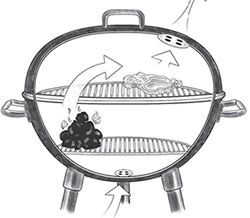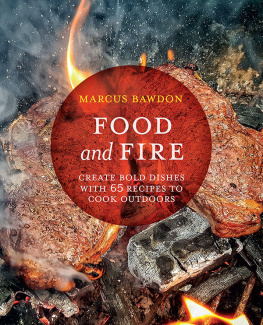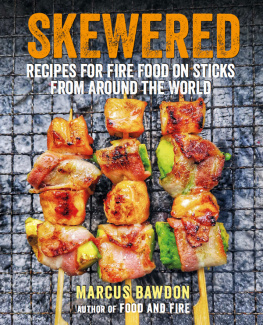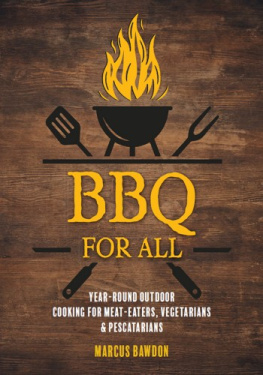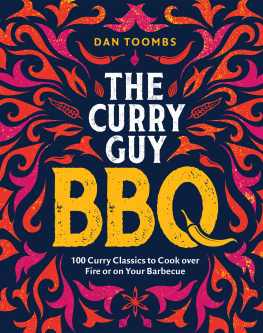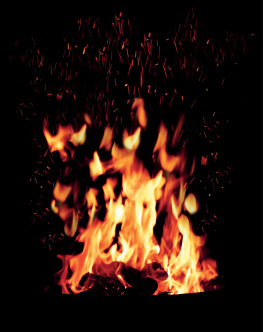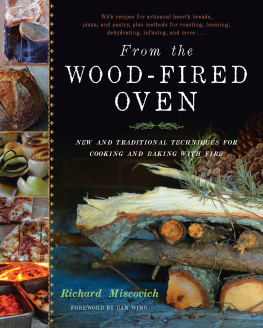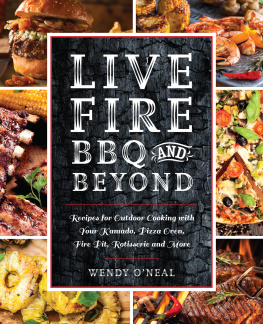FOOD
and FIRE

MARCUS BAWDON
FOOD
and FIRE
CREATE BOLD DISHES
WITH RECIPES TO
COOK OUTDOORS

Published in 2019 by Dog n Bone Books
An imprint of Ryland Peters & Small Ltd
2021 Jockeys Fields341 E 116th St
London WC1R 4BWNew York,
NY 10029
www.rylandpeters.com
10 9 8 7 6 5 4 3 2 1
Text Marcus Bawdon 2019
Design Dog n Bone Books 2019
The authors moral rights have been asserted.
All rights reserved. No part of this publication may be reproduced, stored in a retrieval system, or transmitted in any form or by any means, electronic, mechanical, photocopying, or otherwise, without the prior permission of the publisher.
A CIP catalog record for this book is available from the Library of Congress and the British Library.
E-ISBN: 978-1-91102-695-2
ISBN: 978-1-91102-688-4
Printed in China
Editor: Caroline West
Designer: Eoghan OBrien
Photographer: Marcus Bawdon
Additional photography: Matt Austin ()
Illustrator: Chris Ledward
Contents
DIRTY
CAMPFIRES and FIREPITS
CAST-IRON COOKING
GRILLING
ROTISSSERIE AND SKEWERS
SMOKE
WOOD-FIRED OVENS
ON THE SIDE
SWEET THINGS
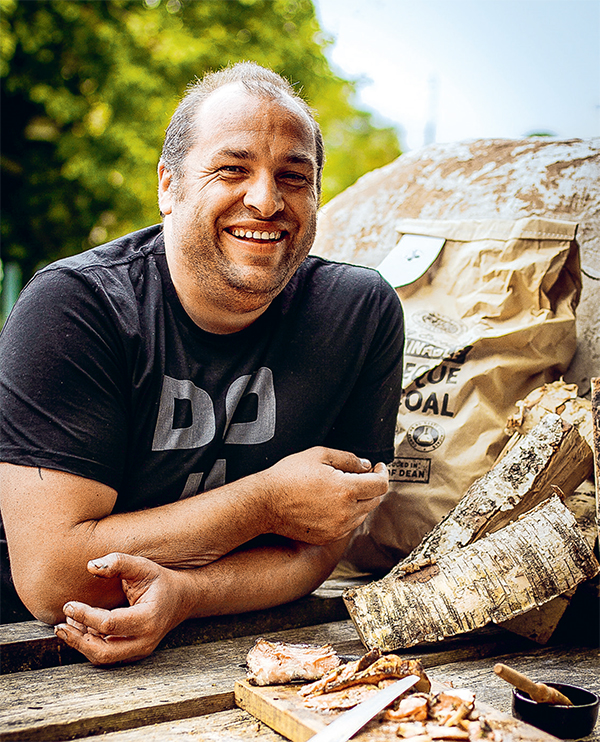
IF YOU ARE NEAR A FIRE, YOU CAN COOK!
Barbecuing is a primal technique for cooking food; there is often nothing simpler. You dont always need fancy gadgets, just food and fire. By cooking directly in the embers of a fire, you take the simplest of foods and turn them into something special. You only need good embers, quality lumpwood charcoal, or the embers of a hardwood or fruitwood fire. You can then simply place the food straight in the embers Thats it. Here, I look at the simplest of barbecue techniques that use a minimal amount of kit, meaning anyone can achieve delicious results.
I love cooking in this way and I am massively inspired by proponents of this style, such as chefs Francis Mallmann, Adam Perry Lang, and Niklas Ekstedt. For certain ingredients there is no better way of cooking themthe exposure to direct heat caramelizes food like no other way. It is also a way of lifeto appreciate food cooked outdoors, to experience lots of big bold flavors, to use your hands to eat, and to enjoy life to the full.
I grew up in front of the fire. On cold nights, my large family would sit in front of the flames and together we would cook honest, simple food in the embers of the fire. Jacket potatoes with charred crisp skin were the family favorite, a slab of butter melting into the middle. Toasting chestnuts in the embers was another prized activity and these taste memories are locked into my soul now. I then started to work in many far-flung places, where I was exposed to different flavors and new food cultures. I traveled extensively and learned to cook many new styles, constantly expanding my flavor palate. Visits to Morocco, Thailand, India, and Africa were all a huge influence on me.
When I moved to a house in rural Devon, southwest England, I started to cook more and more in the garden: campfires, smokers, and wood-fired ovens all started to appear. This has built to an all-encompassing passion that is unbelievably versatile. On the one hand I cater for 12-course feasts, cooking over fire and smoke and serving my creations on long, elegantly dressed tables. On the other, I love to delve into the world of street food, dishing up humble but exciting creations inspired by grilling cultures around the world. One of my proudest moments was being crowned King of Meatopia at the inaugural London Meatopia, one of the UKs biggest barbecue events. Youll find my winning recipe for a Dirty Tomahawk Steak on .
I love to show people what is possible with flame from basic fire control to creating feasts and explain how to cook on anything from simple fire pits to hi-tech pellet grills. This has led me to run a busy Facebook GroupCountryWoodSmokewhere people learn and share various artisanal techniques, such as bacon curing, smoking, and bread making. Alongside this I run the UK BBQ School, where I teach everyone from beginners to chefs looking to learn new skills. I also regularly host and demonstrate at outdoor cooking events, with whole weekends spent teaching butchery, fire control, grilling, smoking, and barbecuing. On top of that, Im a barbecue judge at popular events including Grillstock, Qfest, and Pengrillie, and I am a Kansas City BBQ Society Certified BBQ Judge. You could say my passion for food and fire is all-encompassing.
For me, now, all of the best times spent with family and friends are in front of a fire, be it drinking whisky round the firepit with good mates, or sitting in front of the woodstove with my children, toasting marshmallows and chestnuts. I look forward to sharing some of these moments and the passion I have for food and fire with you.
The life of a fire
This may sound rather deep for this book, but Im a great believer in viewing a fire as you would a persons life. You have the inception, or the spark of fire that starts things off, the noisy crackle of an infant flame, and the youthful exuberance of a raging inferno. Things then calm down and you reach a plateau (which is the best time to cook), before settling into a comfortable, stable bed of embers and gradually dwindling away to ashes.
I see every time I light a fire as a huge opportunity to cook some wonderful food. If you make good use of the different stages of a fires life, then you can maximize those opportunities to turn out memorable meals. For example, do you need the high searing heat of peak red-hot embers or a more sedate cinder bed for slow mellow cooking?
A fire is a simple thing of three parts:
Fuel Air Heat
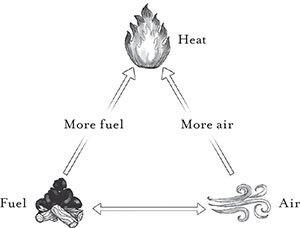
If you remove one of these parts, the fire will go out. However, if you understand how these parts relate to each other, then you will be able to control the heat on a barbecue. The most important part of a fire to maintain is what I call the heart always have a portion of the fire where there is new fuel and a pile of embers to maintain the heat of the fires heart. As soon as you spread out the embers, you lose the heart of the fire. You can always draw the embers out from the heart of the fire and cook over these. If you think a fire is cooling prematurely, then it may have lost its heart, so pull together some of the embers to create more heat and add more fuel.
A lot of people choose a gas barbecue because its quick and the heat can be controlled easily by turning the dials. I see the control of heat on a wood or charcoal barbecue in a similar way. The first stage in managing a fire is controlling the amount of fuel you light; this is your primary temperature control. If you have too much lit fuel, then you will have a raging-hot fire (although this may be what you want, of course). Once you have a good feel for the amount of lit fuel that will provide different temperatures, you can tweak these temperatures using the air vents on the barbecue.
